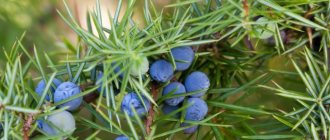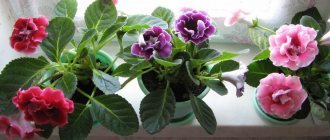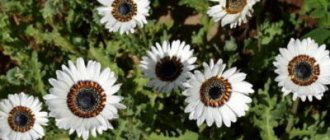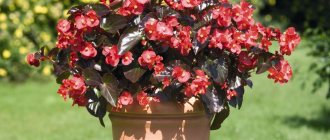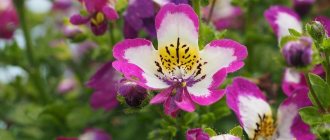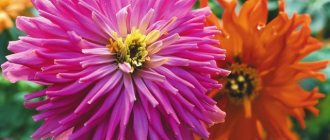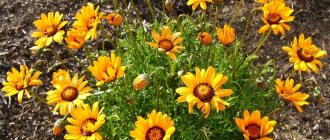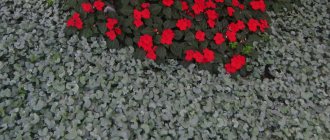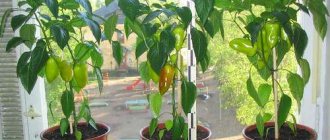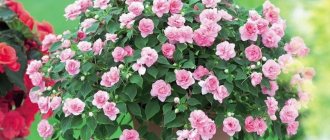Popular types and varieties of aquilegia
More than a hundred varieties of aquilegia have been bred, but only a few of them are grown decoratively. The following types are especially popular:
Alpine . With proper care of the plant, the stems of this type of aquilegia grow up to 30-80 cm in height. The flowers of this variety grow quite large, up to 5-8 cm in diameter. There are spurs on the flowers - they are slightly curved and not very long. The color palette of this species includes various shades of blue.
Alpine
Ordinary . It belongs to the European species, reaches a height of 40-80 cm. The flowers grow about 5 cm in diameter. Varieties of this species come in various shades, but blue and purple are the most common. Flowers come with and without spurs, simple and double. This species is resistant to severe frosts.
Fan-shaped . There is another name for this species - Aquilegia Akita. The stems of the plant grow up to 60 cm in height, and the flowers are large – more than 5 cm in diameter. The flowers have spurs - they are quite long and slightly curved. Up to 5 large flowers can grow on one peduncle. The main shades of the variety are blue, pinkish, lilac-violet. The flowers have a fuzzy white border around the edges. This type of aquilegia reproduces very well by self-sowing.
Hybrid . The flowers are quite large - they grow about 9 cm in diameter, they come in various shapes and shades, there are varieties with and without spurs, the flowers are both double and ordinary. The height of the plant stems can reach 1 m.
Canadian . The flowers of this species are red-yellow in color, with long spurs. This type of aquilegia grows well in the shade and loves moist soil.
Dark . The flowers are small - up to 4 cm in diameter, drooping, dark shades predominate. The spurs are small, but very beautifully curved. Flowering of this species begins in early summer. Grows well in both partial shade and shade. With insufficient watering, it can quickly wither in sunny areas.
Skinner's Aquilegia .
The flowers are drooping, red-yellow in color, the spurs are long and straight. This type of aquilegia is not afraid of frost. Tolerates even the coldest winters well. Aquilegia goldenflower . The flowers are large, with a golden tint and long spurs. Tolerates cold and dry weather well.
Aquilegia olympic . Height is 30-60 cm, the stems are covered with thick fluff. The flowers are light blue, quite large – about 10 cm in diameter. There are long spurs. Flowering period is May-June.
In addition to these species, there are other varieties of aquilegia, for example, ferruginous, blue, small-flowered and bicolor, Siberian and others.
The most popular varieties of Aquilegia:
- Barlow Rose. Plant height is up to 80 cm. The flowers are large, pale pink in color, with a terry border.
- Winky. This variety is often used for garden and indoor floriculture. The height of the plants is no more than 35 cm. The flowers are red, purple, pink, directed straight upward. Blooms in May-June.
- Blue Star. Large flowers, up to 10 cm in diameter. The color is dark blue with a white core. Height is about 80 cm.
Aquilegia: description, characteristics of the flower
The aquilegia flower develops within two years. The first year of life is characterized by the formation of a bud, the so-called renewal point, which is located at the base of the stem. The formation of a rosette at the root occurs in the fall, and in the spring the leaves of the rosette die off and a peduncle forms in their place. During flowering, single flowers form on the stems.
Aquilegs
The appearance of the flowers of this ornamental plant depends directly on the variety of seeds. There are such varieties as alpine, ordinary, ferruginous and many other types. You can see flowers of different colors and shapes with double petals. These can be either single-colored or multi-colored petals. The flower itself can be red, purple, pink, yellow and other shades. The background for such a quivering flower is bright openwork leaves, as well as spurs, thanks to which aquilegia is quite difficult to confuse with other flowers. The most popular varieties:
- common aquilegia, grows up to 80 centimeters, tolerates cold well, popular varieties are low-growing and terry;
- hybrid - can be found more often than others, the most famous variety is called the Snow Queen, grows to a height of about 60 centimeters;
- Siberian aquilegia, which is found in the forests of Siberia, grows up to 70 centimeters;
- fan-shaped - differs in frost resistance, grows up to 30 centimeters in height;
- the small-flowered variety is distinguished by small flowers and grows up to 30 centimeters;
- star - distinguished by openwork flowers, grows up to 80 centimeters in height.
When to sow aquilegia for seedlings
Aquilegia can be grown for seedlings in containers or in open ground, and sowing can be done both in spring and autumn.
Spring sowing in seedling boxes is usually carried out in March, but preparatory work (stratification, scarification) begins a month before - in late January-early February. And when 3–4 true leaves appear on the plants, they are transplanted into open ground.
When sowing in autumn in open ground, stratification is not required. Aquilegia seeds can be sown in a temporary bed. When the seedlings appear in the spring and grow a little, they are transplanted directly into the flowerbed.
Planting and caring for aquilegia
- Planting: sowing seeds into the ground immediately after collection or in March for seedlings after stratification of the seed, followed by planting the seedlings in open ground in June.
- Flowering: June-July.
- Lighting: bright sunlight or partial shade.
- Soil: light, loose, moist, rich in humus.
- Watering: infrequent, but regular, in dry hot weather - frequent.
- Fertilizing: 1-2 times per season with complete mineral or organic fertilizer in liquid form.
- Reproduction: seeds, cuttings and dividing the bush.
- Pests: aphids, spider mites, nematodes, cutworm caterpillars.
- Diseases: rust, powdery mildew, gray rot.
Read more about growing aquilegia below.
plant (lat. Aquilegia) , or columbine , or orlik , belongs to the genus of herbaceous perennials of the Ranunculaceae family. According to various sources, there are from 60 to 120 species of plants growing in the mountainous regions of the Northern Hemisphere. About 35 species are grown in culture. There is disagreement about the origin of the Latin name: some claim that it is derived from the words aqua - “water” and legere - “to collect”, while others believe that the name is based on the word aquila, which means “eagle”.
Aquilegia has long been known in the world of flower growers and beyond. It is also mentioned in fiction, for example, in “Hamlet” Ophelia offers her brother Laertes a columbine flower (as the English call aquilegia). And in the paintings of medieval artists, the aquilegia flower symbolized the presence of the Holy Spirit.
- Brunner: growing from seeds, types and varieties
Growing aquilegia from seeds step by step
Before sowing seeds for seedlings, preparatory work is first carried out, and then the sowing itself is carried out.
Preparing the soil and container
Aquilegia loves light soil that does not accumulate moisture and is moderately nutritious.
To grow aquilegia from seeds, you can use a universal mixture that is sold in specialized stores, or you can prepare it yourself.
You can use the following mixture options:
- turf soil, leaf soil, humus, river sand;
- turf soil, humus, sand.
All components are taken in equal parts.
It is better to grow seedlings in tall boxes or containers so that the long roots of the plant can go deeper. But at first, seeds for seedlings can be planted in small containers (for example, plastic containers with lids). And in the future it will be possible to transplant the seedlings into separate and deeper containers (pots or cups), in which drainage holes will need to be made.
About a day before planting the seeds, the substrate is poured into the container and lightly compacted. The soil is watered and excess liquid is allowed to drain out.
Before sowing the seeds, the soil must be sifted well to make it looser. This will help the seeds to hatch quickly and easily. It is also necessary to disinfect the soil by spilling it with a fungicide or adding phytosporin to the substrate.
Seed preparation
Aquilegia seeds are active only for one year, then their vital energy weakens significantly. To provide yourself with good seed material, you can use the following tips:
- seeds are sown immediately after they are collected;
- the collected seeds are stored in a cool, dark place;
- a month before planting, stratification or scarification is carried out;
- treat the seeds with a solution of growth stimulants.
As mentioned above, when sowing in spring, the seeds must be hardened. With the help of hardening, you can achieve more active and friendly shoots. The seed material is kept in the refrigerator (i.e. subjected to stratification) for 1-1.5 months, at a temperature of 0 +5°C. Seeds are placed in damp sand or on moistened cotton pads.
You can also carry out scarification (exposing the seeds to heat) - the seed is kept for about 30 days at a temperature of +34-36 °C.
Important! Stratification or scarification improves seed germination. But this does not mean that without these agricultural techniques nothing will germinate, especially if you do not doubt the quality of your seeds.
Sowing
Sowing aquilegia seeds for seedlings step by step:
- The container or box is filled with a nutrient mixture.
- The soil is well moistened with a spray bottle.
- The seeds are evenly distributed over the entire surface of the soil and sprinkled with 0.5 cm of soil.
- The plantings are moistened with a spray bottle.
- The container is covered with a lid (if a container is used) or covered with film to create a greenhouse effect.
- Containers with plantings are placed in a warm place. Aquilegia seeds germinate well at air temperatures of + 18-22 °C.
When the first shoots hatch (about 10-14 days), the cover is removed.
Advice! Since aquilegia seeds are very small, it is convenient to plant them using a toothpick, which must first be moistened with water.
Sowing aquilegia in the snow - video
Sowing
To grow seedlings, it is necessary to prepare sufficiently deep boxes. This is explained by the tap root system of the plant, in which a long main root is formed.
The soil is prepared in advance by mixing in equal quantities
- sand;
- leaf humus;
- turf ground.
A day before sowing, it is placed in boxes, compacted and watered with light pink potassium permanganate. The soil should be moist, but not soggy.
Sowing is done in March, scattering the seeds over a leveled soil surface. It is important not to thicken the crops. They are rolled with a tin can or pressed down with the palm of your hand. Sprinkle the same mixture on top through a sieve in a layer of no more than 3 mm. You can sprinkle the crops with a layer of washed and calcined sand (0.5 cm).
The next step will be to moisten the crops with a spray bottle and arrange a mini-greenhouse. To do this, the box is covered with a translucent material - glass or polyethylene, since they need diffused light to germinate the seeds.
Seedling care
Growing aquilegia seedlings need sufficiently long daylight hours and moderate watering. Water moderately so as not to provoke the appearance of a “black leg”.
Aquilegia develops a root system quite quickly, and it also has a very long taproot, so if the seeds were sown in a shallow container, then when the seedlings have 2-3 true leaves (about 30 days after planting), it will need to be transplanted into deeper containers (with drainage holes).
Do the dive in the morning or evening. Immediately after transplanting, the plants are well watered. In the future, watering should also be moderate as the top layer of soil dries. Every 10-14 days, seedlings are fed with complex fertilizers.
Caring for the plant after transplantation
Further care of the catchment consists of periodic weeding, watering, loosening and proper feeding. It is not worth watering often, since aquilegia has a long root and usually lacks moisture. But you need to loosen more often, especially after rains and watering. As for feeding, it is better to fertilize the catchment area with mineral compounds, thanks to which the plant will bloom luxuriantly throughout the entire period. In summer, the plant needs to be watered with mullein.
Those varieties of flowers that grow up to 80 centimeters should be tied so that they do not break.
When to plant aquilegia in open ground
When the threat of return frosts has passed, the plants are transplanted into open ground. This happens about a month after picking (or two months after planting the seeds); by that time the seedlings will have grown well and become strong. It is better not to rush with the transplant and wait until the air warms up to at least +15°C.
Important! The plant can withstand temperature drops of no more than +5 degrees.
Aquilegia is a fairly unpretentious plant; it can be planted both in the sun and in partial shade, and even in the deep shade of garden trees or bushes, since it is shade-tolerant.
Planting aquilegia seedlings in a permanent place occurs as follows:
- Choose the most suitable place on the site in partial shade or shade;
- Prepare holes according to the size of the container in which the seedlings grew;
- Water the planting container in advance so that you can easily remove the seedlings from it.
- Carefully remove the plants, place them in the holes, sprinkle them with soil and press them down.
- Seedlings are planted at a distance of at least 30-35 cm from each other.
- Planted plants are well watered.
- The space between the plants and the ground around the stems are well mulched. You can use hardwood sawdust, hay, straw or dry peat as mulch. Mulch will help retain moisture and prevent increased weed germination.
In the first year, for aquilegia, choose a place protected from the wind and protected from direct sunlight, since young plants can simply burn under the scorching sun.
The land for planting is prepared in two to three weeks:
- dig up;
- make deep holes (about 25 cm) so that the seedlings fit together with the earthen ball;
- if necessary, lay out a drainage layer;
- a small amount of humus or compost is placed at the bottom of the holes;
The seedlings are placed in prepared holes, covered with soil and well moistened.
We grow aquilegia using seedlings
Seeds for seedlings are sown at the end of January or February. For growing in seedlings, the following soil composition is recommended: 1/3 humus, 1/3 turf soil, 1/3 sand. At FORUMHOUSE we told you how to make leaf and turf soil yourself.
We fill a deep container for seedlings with soil, water it well with warm water, sprinkle with stratified seeds and sprinkle literally a couple of millimeters of soil. It is advisable that the soil be sifted, this will ensure even seedlings.
To obtain strong seedlings, it is recommended to keep containers with crops at a temperature of +16 - +18 degrees. This is the ideal temperature. Water the young entrances very carefully, avoiding both flooding and overdrying. Direct sunlight is also unacceptable.
After the appearance of the second true leaf, the seedlings dive: ideally immediately into the exhaust gas, but also into peat pots. As a last resort - in large boxes. The most important thing is careful handling of the rhizome; it should not be damaged. Adult seedlings are cared for in the same way as seedlings; you can provide additional lighting.
In OG, aquilegia seedlings are planted at a distance of 20-40 cm between plants, depending on their size. Young aquilegias are delicate creatures, so at first it is important to protect them from aggressive weeds by regularly weeding them. You should also be sure to carefully loosen the soil after each rain or watering. It is better not to be overzealous with watering; adult plants are generally recommended to be watered only during drought.
Sometimes aquilegias bloom in the year of planting. In this case, it is important to prevent seed setting - cut the flowers and let them please you in the bouquet.
Catchments are easy to care for - in addition to rare watering and weeding, pre-winter mulching with humus or peat is carried out, and in the spring the perennial is slightly pestered so that its rhizome is not exposed and does not rise.
How to properly care for aquilegia in summer
In the first year after planting, aquilegia does not bloom; all the plant’s efforts are aimed at adapting to a new place and growing a powerful root system.
But already in the second year after planting - at the end of May-beginning of June, you can enjoy the first flowers. Aquilegia blooms in full force only in the third year after planting.
Caring for a planted plant comes down to the following procedures:
- Timely removal of weeds and loosening of the soil.
- Fertilizer application.
- Moderate soil moisture. The plant has a rather long central root, so it rarely suffers from lack of moisture.
- Tying up tall species. The plants are tied to wooden stakes using twine.
As the roots of aquilegia grow, they often begin to protrude from the ground; they are sprinkled with rotted peat or just a new ball of soil. This procedure is carried out in spring and summer.
For lush flowering (2-3 weeks after planting), mineral fertilizers are applied:
- superphosphate – 50-60 grams per 1 sq. m;
- potassium salt – 15-20 grams per 1 sq. m;
- saltpeter - 20-30 grams per 1 sq. m.
In summer, aquilegia is watered with organic fertilizers. Use diluted manure and urea. You can also use ready-made complex fertilizers. This will help the plant gain more green mass.
Grown plants that are already 2-3 years old are fed twice a season. In spring, nitrogen fertilizers are used, and when buds appear, potassium fertilizers are used.
Aquilegia is one of those plants in which it is necessary to remove dry (which have already bloomed) flower stalks so that the plant does not waste its energy on setting seeds.
Aquilegia: planting seeds
Heliotrope flower - growing from seeds
To figure out how to plant aquilegia from seeds, you do not need to be an experienced gardener. To plant these seeds, it is worth choosing deep containers. If you don’t want to bother with plastic or wooden boxes, then you need to find containers with which you can plant the seedlings directly into the ground. For example, paper bags. Then planting will be easier, and there will be no need to be afraid that the roots will be damaged during replanting.
Containers for planting seeds
For aquilegia you do not need to select a special substrate. It is enough to take a standard substrate or a simple soil mixture.
Methods for propagating aquilegia
Aquilegia can be propagated not only by seeds, but also by cuttings and dividing the bush.
Cuttings are considered the simplest method of plant propagation. Cuttings are harvested in the spring, long before the leaves begin to bloom. First, young and large shoots with internodes are cut off.
The cut is treated with a growth stimulator. Shoots are planted directly in open ground, but you can start by planting them in any container. Next, the cutting is covered with plastic wrap or a plastic bottle.
For the first 10 days, the shelter in the plants is not removed at all, and then it is periodically ventilated (no more than half an hour a day) and moistened the soil. The cuttings are planted in loose soil with good drainage. When planting, add coarse granulated sand. When the cuttings adapt and take new roots, they are transplanted to a permanent place of growth.
The method of dividing a bush is not used very often. It is used, as a rule, if there is a need to preserve a plant variety. The roots of aquilegia grow quite deep into the ground, the plant is fragile and does not tolerate the procedure of division and replanting. The bush is divided in early spring, or in early September. For division, use bushes that are more than 3 years old.
The procedure for dividing aquilegia is carried out as follows:
- The bushes of the plant are dug up, the roots are well cleaned of adhering soil.
- All stems are trimmed and leaves are completely removed.
- The root is divided into two even parts. Both divisions must have healthy buds and strong roots.
- The place where the cut was made is well treated with crushed coal, and the cuttings are carefully planted in previously prepared soil.
- The soil is pressed well and watered.
Sowing seeds in spring
The plant can be grown either from seeds or by dividing an adult bush or cuttings. Growing from seeds involves two methods:
- sowing in open ground;
- growing from seedlings.
Outdoor sowing takes place in mid-April. The seeds are laid out in a shallow hole at a distance of about 25 centimeters from each other, and then sprinkled with a small layer of soil. The bed is covered with a layer of film until the first shoots appear. When two or three true leaves appear on the seedlings, they can be replanted.
Important! To increase the germination rate of seeds, they can be treated with sandpaper, slightly damaging the hard shell; this must be done carefully so as not to damage the seeds themselves.
To sow seedlings, you need to prepare the soil in advance, which will consist of deciduous soil, sand and turf. Only deep containers are suitable for aquilegia, since the plants have well-developed roots. Before sowing, you need to soak the seeds in a growth stimulator, and then place them on the surface of the prepared soil, cover them with a thin layer of soil, lightly press them down and cover them with a layer of film.
Little birds of paradise. Photo used as illustration. Source: Yandex.Images
How to plant by dividing a bush and cuttings?
The vegetative method of propagation (division) of aquilegia is only suitable for a plant that is at least three years old. The bush is divided into several parts, each of which has buds and good roots. Separation manipulations should be carried out in August so that the roots take root well in the new place.
Cuttings are usually carried out for especially valuable and expensive varieties of aquilegia. Cutting manipulations are carried out in the spring, when the plant puts out fresh shoots. The young shoot of the flower is cut off at the root and planted in light sandy soil, watered well. It is imperative to ensure that the top soil of the cutting is always moist.
How and when to collect your seeds
Aquilegia seeds are sold everywhere, and you can buy them at any flower shop, or you can collect them yourself from plants already growing on the site. If this plant is already growing in your garden or flower bed, then the seeds for its propagation can be collected very simply. They are also stored well, and do not lose their quality throughout the whole year.
Aquilegia seeds begin to ripen in early August and are harvested immediately after small green pods appear on the stems. If they are not collected in time, they begin to crumble to the ground. It is necessary to dry the seeds at room temperature, placing them on a saucer or on a napkin.
But you can also not collect the seeds, but leave them on the bushes, then you can reproduce by self-sowing.
Sowing aquilegia seeds at home
The optimal time for sowing aquilegia seeds is considered to be sowing immediately after harvest, in the fall. When purchasing seeds, sowing to obtain higher germination percentages is also best done in the fall. An alternative time frame is early spring, but in this case, aquilegia seeds will require stratification (preferably grown through seedlings, but can also be sown in the ground).
When sowing aquilegia into the soil of freshly harvested seeds in the fall, no pre-planting treatment is needed. Sowing is carried out before winter, and the whole procedure comes down to a few steps:
- Carefully sow the seeds into a seedling bed with prepared, dug, loosened soil.
- Cover them on top with a thin layer of soil (about 0.5 cm). Water carefully.
- Mulch the crops with humus or compost, covering them with a thin layer of dry leaves (any mulching material available to you will do).
When sowing aquilegia in the spring, both for seedlings and in the ground, it is advisable to stratify the seeds and store them in the cold. There are several options for this procedure:
- keep aquilegia seeds in the refrigerator for 4-6 weeks;
- mix the seeds with soil, place in a container and bag and keep in the refrigerator all winter;
- take aquilegia seeds or a mixture of seeds with sand or substrate outside, place them in a snowdrift, etc.
Some gardeners are experimenting with the reverse procedure - keeping the seeds in heat (35 degrees for 4-5 weeks) or scarification (processing with sandpaper). But, as a rule, more friendly shoots of aquilegia are obtained when cooled.
When sowing seedlings in the spring with self-collected or purchased seeds harvested in the fall of the previous year, you must:
- Fill the container with the substrate and level its surface, pour warm water over the substrate.
- Lightly scatter the stratified aquilegia seeds over the surface and sprinkle a few millimeters of soil (preferably sifted) on top.
- Transfer the containers to room conditions for germination, covering them with glass or film.
You can sow aquilegia seeds in spring and in open soil. The optimal time for sowing seeds is April or early May, when the soil warms up. Seeds freshly collected in the fall of the previous year can be used without stratification. Aquilegia seeds are also sown to a depth of half a centimeter, as in the fall, but the crops are covered with film on top. Germination requires regular watering. The shelter is removed only when friendly shoots appear.
If you want to simplify the growing process, sowing can be done later, but then the young plants will have to be provided with more careful care.
The most difficult process is sowing very old seeds. In this case, the procedure changes slightly; stratification is carried out after sowing:
- Aquilegia seeds should be washed in water and soaked for several hours in a warm solution of potassium permanganate.
- Sow the seeds in a leveled substrate and lightly cover with soil.
- Without covering the containers, leave them at room temperature for 3-4 days.
- The containers are taken outside or placed in the refrigerator for stratification for 4-6 weeks.
- Bring the crops back into the heat and place them in standard room conditions.
Pruning the plant after flowering, preparing for winter
When the plant has finished blooming, remove all flower stems, as they have already lost their decorative beauty. They also inspect the entire bush at the same time - remove dry and damaged leaves. You can also cut off the entire above-ground part of the bush, because with the arrival of spring new stems will grow.
It is also very important to check the base of the flowers; in mature plants (over 3 years old), roots begin to emerge from the soil. To prevent the plant from freezing in winter, all roots protruding from the ground are covered with compost, pre-mixed in equal proportions with manure. Such a shelter will protect the roots well from severe frosts and serve as additional fertilizer.
With such a variety of aquilegia varieties, every gardener will be able to choose a variety that will decorate his plot with delightful flowers. You can choose several types of this plant and create a fabulous composition that will decorate your garden or local area.
Video of aquilegia in the garden
Watch the video to see how beautiful watersheds grow and bloom, what types and colors of buds there are, and where in the garden you can plant aquilegia.
You will be interested to know: Growing alyssum from seeds: when and how to sow seedlings, planting and garden care
As you can see, there is nothing difficult about growing aquilegia from seeds at home. Knowing when and how to sow seeds for seedlings, how to care for plants at home and in the open ground, you will grow beautiful flowers that will decorate your garden for many years.
Aquilegia in landscape design - photo
Aquilegia yellow
Preparing for winter and care features for the next season
In the fall, you can prune the bushes, but this can only be done after they have completely withered. This procedure is carried out with scissors almost to the root. No other actions are provided here. Further germination should be expected next spring. It happens without the participation of the gardener.
After the snow melts and the plants awaken, no watering is required. You just need to loosen the soil so that young shoots can emerge more successfully. Weeds grow in small quantities during this period. But it's better to remove them. It is also allowed to feed the plants a little. It is better to use dry fertilizer in the form of granules. Just scatter it on the surface of the ground around the sprouts.
During the entire growing season, it is recommended to feed the plant up to two times. It is considered undemanding in this matter. On the contrary, a large amount of fertilizer will negatively affect growth.
In June, aquilegia can show its first flowers. At the end of the month the buds are already quite large. Some are blooming, and individual units have not yet opened. Inflorescences may not be observed at all on all plants.
Specimens planted at the same time may well differ in the quality and quantity of flowers. Even if they are located close to each other. For example, if next to one of them there is another tall and spreading plant. It can provide great shade. Or if a hybrid union has occurred with other flowers growing near the aquilegia.
